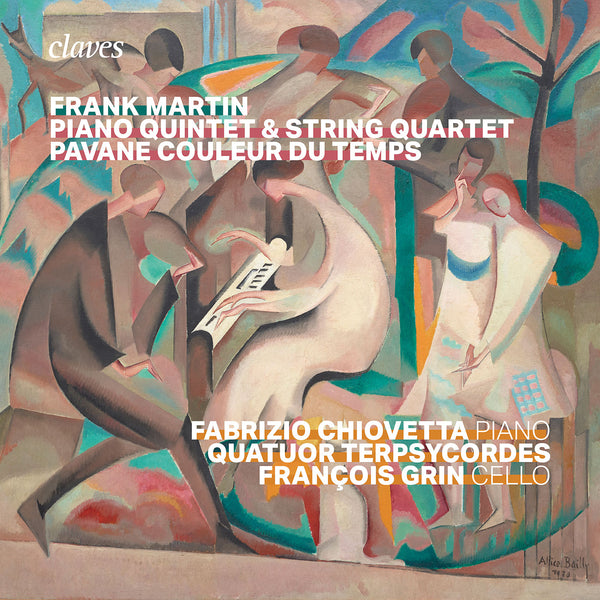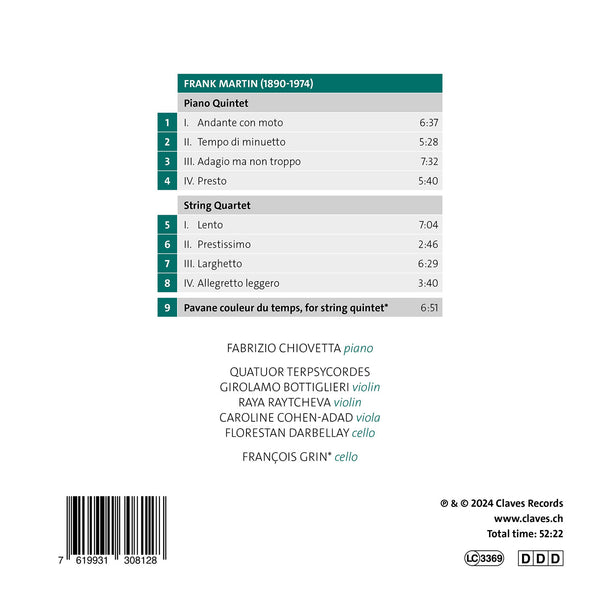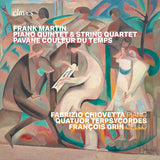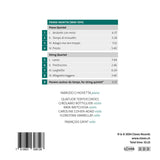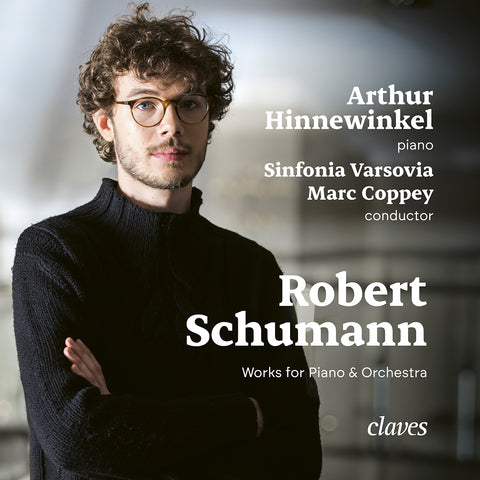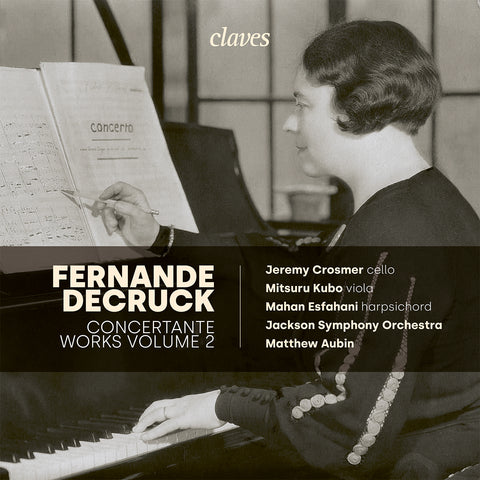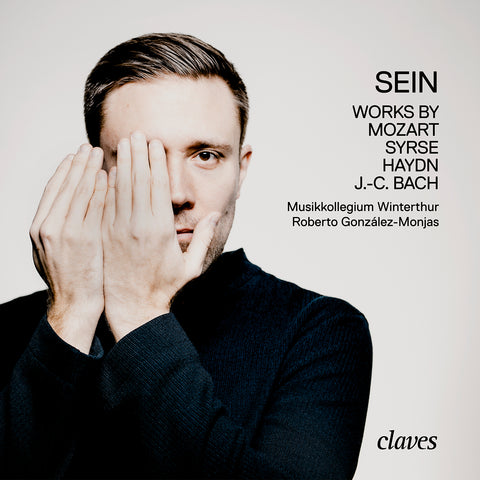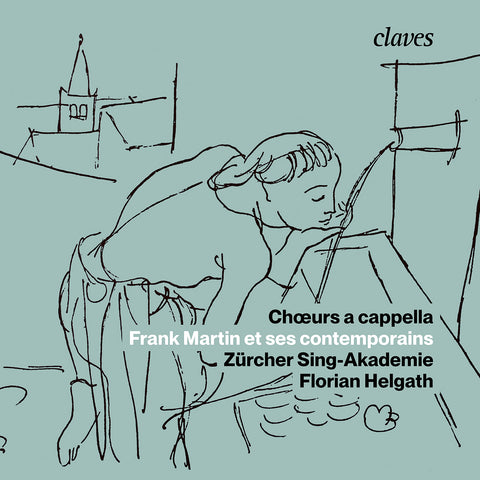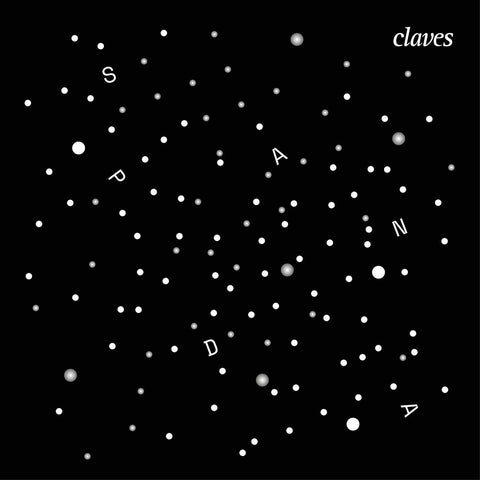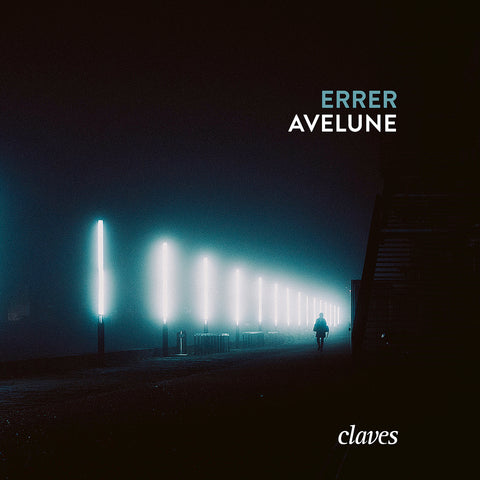(2024) Frank Martin: Piano Quintet, Quartet, Pavane couleur du temps
Category(ies): Chamber Piano
Instrument(s): Cello Piano Viola Violin
Main Composer: Frank Martin
Ensemble: Quatuor Terpsycordes
CD set: 1
Catalog N°:
CD 3081
Release: 12.04.2024
EAN/UPC: 7619931308128
This album is now on repressing. Pre-order it at a special price now.
CHF 18.50
This album is no longer available on CD.
This album has not been released yet. Pre-order it from now.
CHF 18.50
This album is no longer available on CD.
CHF 18.50
VAT included for Switzerland & UE
Free shipping
This album is no longer available on CD.
VAT included for Switzerland & UE
Free shipping
This album is now on repressing. Pre-order it at a special price now.
CHF 18.50
This album is no longer available on CD.
This album has not been released yet.
Pre-order it at a special price now.
CHF 18.50
This album is no longer available on CD.
CHF 18.50
This album is no longer available on CD.
NEW: Purchases are now made in the currency of your country. Change country here or at checkout
FRANK MARTIN: PIANO QUINTET, QUARTET, PAVANE COULEUR DU TEMPS
FROM THE QUINTET TO THE QUARTET: FRANK MARTIN ON THE ROAD TO SELF-DISCOVERY
Chamber music meanders throughout Frank Martin’s career in a multitude of different ensembles and titles, ranging from the classical to the more unexpected, such as the Rhapsodie for string quintet with double bass, the Sonata da chiesa for viola d’amore and organ, the Ballade for trombone and piano or the Petite fanfare for brass sextet. Within this abundance, the composer approached only sparingly the most historically established genres. His only string quartet is a late work, his last chamber music piece. On the contrary, the Quintet for piano and strings and the Pavane couleur du temps are among his earliest contributions in this field.
At the end of 1918, Martin married Odette Micheli, and the young couple moved to Zurich. The Quintet for piano and strings was composed in this city a few months later. The work belongs to a period during which the composer’s style gradually freed itself from post-romanticism and became more personal. Martin’s recent meeting with Ernest Ansermet coincided with a marked interest in the music of Claude Debussy and Maurice Ravel, of whom the conductor was a strong advocate. The Quintet bears witness to this influence but goes far beyond it. An unusual conception of this musical genre can already be heard in the very first bars. Over a sorrowful accompaniment by the violins and viola, the cello introduces a plaintive, passionate melody. It is not until the sixteenth bar that the piano makes a timid appearance. With only a few exceptions, the piano remains in the background throughout the piece, confining itself to providing colour or rhythmic support. This is a far cry from the piano quintet tradition, which, from Johannes Brahms to Gabriel Fauré and César Franck, has placed the keyboard on an equal footing with the strings. It is in the minuet that the spirit of Ravel is most explicitly found: the dance is highly stylised here, and both the rhythmic momentum and certain pizzicato and arpeggiated chord effects recall the world of the French composer.
It is often said that the Quintet’s slow movement recalls Frank Martin’s fascination for Johann Sebastian Bach. Admittedly, the haunting triplets that open the piece would not be out of place in a Passion written by the German master, but the analogy doesn’t go much beyond that. The composer creates a perfect sense of chiaroscuro between this sombre accompaniment and the luminous arpeggios of the first violin and the viola. A post-romantic tone is heard here, culminating in the central section where the first violin’s playing in sixths and thirds contributes to a polyphony of exacerbated lyricism while the piano remains silent. The strings alone again play the nearly first sixty bars of the finale. The last movement alternates between fugal writing and more transparent passages, with the composer constantly varying the instrumental textures with much ingenuity. Amid this fireworks display, a popular Savoy melody can even be heard.
The Pavane couleur du temps was written for a string quintet in 1920 and then arranged for a small orchestra in 1954. It takes its name from Charles Perrault’s fairy tale Peau d’âne (Donkeyskin), in which a princess, seeking to avoid a dreaded marriage, tests her future and undesirable husband by requesting a gown “the colour of the sky”. Both the title and the reference to Perrault associate the piece with Ravel, who opened Ma Mère l’Oye with the Pavane de la Belle au Bois dormant inspired by the same author. The pavane, a court dance that originated in Italy in the 16th century, came back into fashion at the end of the 19th century thanks to composers such as Camille Saint-Saëns, Ralph Vaughan Williams and, of course, Ravel. Martin’s score has a noblesse and a melodic contour similar to his colleague’s but adds a faster, more tormented middle section. It is a perfect illustration of the French influences to which Martin was then receptive.
Despite Martin’s mastery of string writing in his Quintet for Piano and Strings, he waited until the end of his life to finally devote himself to the string quartet, the supreme chamber music genre. It even took a commission from the Pro Helvetia Foundation for his only quartet to see the light of day in 1967. This mature work opens up a very different world from the other two pieces in this recording. It reveals a language that is as far removed from post-romanticism as from the French aesthetic of the turn of the century, a highly personal form of neo-classicism magnified by a soberly intense expressivity.
As from the first bars, a highly original way of building the dialogue between the instruments is displayed. The initial Lento opens with an extended viola solo, soon taken up in unison with the first violin. A contrasting theme is added on the second violin, with the cello’s pizzicatos in the background. This conversation continues until the cello introduces a new motif, which the other partners comment in turn. The movement is, therefore, not built on the principle of exposition and development but on that of a constant counterpoint fed by several thematic ideas. The dramaturgy of the brief scherzo is based on the opposition between the incessant restlessness of a string of quavers punctuated by unpredictable sighs and the emergence of fleeting melodic elements. Given its nobility, its metre, and the rhythm and tone of its principal theme, the slow movement is a pavane that does not speak its name. Finally, the composer revealed (in À propos de... Commentaires de Frank Martin sur ses oeuvres, published by Maria Martin, 1984) the extra-musical inspiration for the finale: “One night, during a stay in Graz, I dreamt that I saw half-human figures dancing while rising into the air and I knew, in my dream, that this aerial dance was to be the finale of my quartet. Rightly or wrongly, I let myself be guided by this dream and endeavoured to give it a sort of musical equivalence.” The 6/8 metre gives these pages a dancing impulse in a rising line towards the treble. It is with this elfin jig that Frank Martin bid farewell to chamber music.
Yaël Hêche - communiquerlamusique.ch
Translation: Michelle Bulloch - Musitext
FABRIZIO CHIOVETTA
Born in Geneva, Fabrizio Chiovetta, of Swiss and Italian nationality, studied with Elisabeth Athanassova, Dominique Weber, John Perry and Paul Badura-Skoda, of whom he became a privileged disciple.
He has given numerous concerts in Europe, North America, Asia and the Middle East (Menuhin Festival and Sommets musicaux de Gstaad, Princeton Piano Festival, Beijing National Center, Lisztomanias, Festival Berlioz, Shanghai Oriental Art Center, Schloss Elmau), performing under the direction of Gábor Takács-Nagy, Jean-Pascal Hamelin, Arie van Beck and Diego Matheuz. A versatile musician, he is a much sought-after chamber musician, performing with partners such as Gautier Capuçon, Lise Berthaud, Patrick Messina, the Quatuor Belcea, Marc Coppey, Henri Demarquette, Camille Thomas, Pierre Fouchenneret, Sarah Nemtanu, Samuel Hasselhorn, Benjamin Appl, Sophie Karthäuser and Werner Güra; as an improviser, he collaborates with musicians from diverse backgrounds. He also teaches piano at the Haute école de musique in Geneva.
His recordings for Palexa, Claves Records and Aparté have received critical acclaim (Diapason, Choc de Classica, American Record Guide, Gramophone Editor’s Choice).
QUATUOR TERPSYCORDES
The Terpsycordes Quartet redefines the connection between a musical ensemble and its audience. It invents new ways to experience a concert of chamber music and is committed to reaching underprivileged as well as young audiences, in order to share its art with as many people as possible.
Formed in Geneva in 1997, guided by the artistic vision of Gábor Takács-Nagy and nurtured by the teachings of members of the Amadeus, Budapest, Hagen, Lasalle, and Mosaïques quartets, the Terpsycordes Quartet quickly made its mark on the musical scene, notably winning First Prize at the Geneva Competition in 2001, as well as other international competitions (Weimar, Graz, Trapani). Encounters with major 20th century composers such as György Kurtág and Sofia Gubaidulina, as well as personalities from the world of baroque music, including Gabriel Garrido, Chiara Banchini, Florence Malgoire, and Leonardo García Alarcón, contributed to defining and refining the quartet’s aesthetic evolution. Members of the Quartet continue to play regularly with various other ensembles such as Cappella Mediterranea, Gli Angeli Genève, Contrechamps, l’Armée des Romantiques, or Elyma.
The repertoire of the Terpsycordes Quartet spans from the pre-classical period to contemporary creations. Since 2021, it has been performing a complete cycle of Joseph Haydn’s quartets on period instruments at the Museum of Art and History in Geneva, while maintaining a special relationship with major 20th century Genevan composers – Ernest Bloch and Frank Martin. This new album, entirely dedicated to the works of Frank Martin, adds to a discography ranging from Haydn to Piazzolla, widely acclaimed by critics.
The Terpsycordes Quartet is actively engaged in social and educational projects. It offers concerts in partnership with foundations, associations, and facilities for the disabled, those in precarious situations, or in detention. It also collaborates with schools in the City of Geneva. It breaks conventions by offering unique experiences aimed at sharing its passion, including outdoor concerts in unusual locations, musical bike rides, or public rehearsals, thus creating original opportunities to introduce the magic of chamber music to diverse audiences.
The Terpsycordes Quartet is supported by the City of Geneva and by the Republic and Canton of Geneva.
REVIEWS
"Le Quintette avec piano (1919) et le Quatuor à cordes (1966-1967) se situent aux deux extrémités de la carrière de Frank Martin. Le premier, pas encore tout à fait personnel et encore marqué parfois par le postromantisme germanique, est cependant très réussi et comporte notamment un magnifique mouvement lent, d'une expressivité sobre mais intense. Cet Adagio ma non troppo sera transcrit ultérieurement pour quintette à cordes (avec deux violoncelles) sous le titre Pavane couleur du temps. Chef-d'oeuvre d'un compositeur septuagénaire qui sait jouer de toutes les cordes de son arc harmonique - la modalité, la tonalité présente mais toujours élargie par l'hyperchromatisme -, le Quatuor domine l'oeuvre tardif du compositeur. Ces deux oeuvres n'ont guère été enregistrées, même s'il en existait déjà de bonnes versions: Martin Klett et le Quatuor Armida pour le Quintette, avec celui de César Franck (Avi Music, 2022) et le Quatuor Amati pour le Quatuor, avec des oeuvres de Szymanowski, Haller et Vogel (Divox, 1984). Le Quatuor Terpsycordes et Fabrizio Chiovetta, installés de longue date à Genève, étaient évidemment tout désignés pour défendre le répertoire de leur compatriote, avec une sensibilité particulière au jeu des timbres et à la transparence du son." - Jacques Bonnaure, July 2024
"Sidestepping formal stringency, his music speaks straight from the heart, a quality highly apparent within his early Piano Quintet, which is played as such with much conviction by the Quatuor Terpsycordes and pianist Fabrizio Chiovetta. Contrary to most quintets, the piano doesn't play a leading role here but rather underpins the darkly emotive character of the music, a setting that proves very effective. And the String Quartet, written 50 years later and despite its more incisive and angular harmonic tone, still speaks with the same personal spirit. Strangely enough, the first few notes of its Larghetto movement almost sound like a present day version of Bach's Air on the G String, paired down to its fundamental essence. Although Frank Martin's music detached itself from post-romanticism, it never became as self-absorbed or acerbic like most of his counterparts. He remained true to the expressive aspects of music all his life, and the three pieces on this CD are perfect examples of this. If you've never heard this composer's work before, this recording could very well be a great introduction." - Jean-Yves Duperron, May 2024
"Le Quatuor Terpsycordes a été fondé à Genève en 1997. Ses membres (Girolamo Bottiglieri et Raya Raytcheva, violons ; Caroline Cohen-Adad, alto et Florestan Darbellay, violoncelle) collaborent régulièrement avec des partenaires baroques ou attirés par la musique de notre temps. Ils ont enregistré Schubert pour Ricercar, Bach pour Zig-Zag Territoires ou le compositeur mexicain naturalisé italien Javier Torres Maldonado pour Stradivarius, mais aussi Haydn et Schumann pour Claves. Homogènes et chaleureux, avec des sonorités généreuses et épanouies, les Terpsycordes servent à merveille le répertoire de Martin. Le pianiste genevois Fabrizio Chiovetta, de nationalité suisse et italienne, chambriste reconnu, est le partenaire nécessairement discret pour le quintette ; le violoncelliste François Grin, Suisse né à Washington, vient compléter efficacement le quatuor pour la courte Pavane. Un très bel album, hommage à Frank Martin, qui incite le mélomane à approfondir le catalogue d’un compositeur trop peu fréquenté." - Jean Lacroix, June 2024
"Au tournant des années 1920, le compositeur suisse taquine encore la muse ravélienne : la présence d'un second violoncelle ajoute à la gravité intranquille de sa Pavane couleur du temps, dont le titre évoque Peau d'âne - et Ma mère /'Oye, par ricochet. Les Terpsychordes y retrouvent François Grin, prédécesseur de leur violoncelliste Florestan Darbellay. Ecrit dans ses dernières années (1966-1967), l'unique Quatuor à cordes de Martin distille un langage désormais fondé sur une libre tonalité. L'auteur y laisse filtrer ses angoisses existentielles, que tempère une foi chevillée au corps. A l'inverse des Amati (Divox), qui épuraient le discours jusqu'à l'abstraction, les Terpsycordes s'efforcent de lui rendre sa profonde et poignante humanité." - Marc Lesage, July 2024
"Nebst seinen teilweise wuchtigen Vokalwerken hat der Genfer Komponist Frank Martin (1890–1974) stets auch filigrane Kammermusik geschrieben. Der Italo-Schweizer Pianist Fabrizio Chiovetta und der US-Schweizer Cellist François Grin stellen auf diesem Album drei exemplarische Werke zusammen, deren Raffinesse sie mit dem Quatuor Terpsycordes aus Genf zum Klingen bringen. Vom jungen Frank Martin sind das Quintett für Klavier und Streicher sowie die Pavane Couleur du Temps zu hören. Zwei Kompositionen von 1918 und 1920, die Martins Faszination für die französische Postromantik (Ravel oder Debussy) am Übergang zu seinem «persönlichen Stil» dokumentieren. Dieser sollte Martins spätere Werke prägen: eine tonale Variante der Zwölftonmusik. Zu hören ist dies auf dem vorliegenden Album mit dem Streichquartett, einem 1967 entstandenen Alterswerk." - Frank von Niederhäusern, September 2024
"Le quatuor romand Terpsycordes dédie un album entier et très inspiré à Frank Martin, disparu il y a exactement 50 ans. Les trois partitions réunies ont des subtilités qui les placent en marge du canon chambriste. Le Quintette avec piano d’abord, datant de 1919 et joué avec Fabrizio Chiovetta: l’écriture personnelle, tonale mais imprégnée d’influences françaises, n’est pas du genre flamboyant. Elle aménage une tension continue, sans direction univoque. Le compositeur suisse cultive l’art du clair-obscur, à fleur de peau, sans le résoudre. Plus tardif (1966-67) et plus tourmenté, le Quatuor à cordes hésite lui aussi entre pulsations âpres et lyrisme inquiet. Seule la Pavane couleur du temps (1920), pour quintette à cordes (avec François Grin) s’élève, tout provisoirement, vers la lumière." - Elizabeth Hass, June 2024
"Girolamo Bottiglieri ist Primarius des 1997 von ihm gegründeten Quatuor Terpsycordes. Es hat seinen Sitz in der Stadt, in der Frank Martin 1890 zur Welt kam: Genf. Jetzt haben die vier Musiker für das Label Claves drei seiner Kammermusikwerke aufgenommen, unter anderem das 1967 komponierte Streichquartett, das zum letzten Mal vor mehr als 40 Jahren vom Amati Quartett eingespielt wurde." - Burkhard Schäfer, November 2024
"A CD with only works by Frank Martin usually means a welcome discographic addition, although performance and recording quality obviously play an important role. Moreover: it is not given to every musician, not every ensemble to move idiomatically through this repertoire, whether it concerns early or late works by this tone poet. The technical arsenal also speaks a formidable word, but no worries here: these musicians have thoroughly immersed themselves in the musical characteristics of these pieces, and thanks to the ample technical playing arsenal, all in all nothing is left to be desired. The phrasing and articulation in the most virtuoso movements (the concluding Presto from the Piano Quintet and the Prestissimo from the String Quartet) are like something out of a ring, and the lyricism in the slow movements is equally impressive. The Larghetto from the String Quartet is just as much of a miracle in terms of atmospheric description as the concluding Pavane, thanks in part to the Quatuor Terpsycordes." - Aart van der Wal, August 2024
"Merito anche dell’esecuzione del Terpsycordes Quartet, una formazione svizzera nata nel 1997, i cui membri suonano con suono caldo e omogeneo, generosi nel fraseggio specie nei momenti in cui il pathos si fa particolarmente intenso. Ottimo l’apporto del pianista ginevrino Fabrizio Chiovetta e del violoncellista Franc¸ ois Grin che si unisce nella Pavane." - Stefano Pagliantini, October 2024
"Le jeu des interprètes a été très soigneusement préparé, en particulier en ce qui a trait aux distinctions de nuances entre chacun des musiciens ; ils projettent des plans sonores individuels nettement détaillés. Autre aspect remarquable de leur préparation : l’intonation est impeccable malgré des harmonies parfois complexes. La prise de son est tout aussi admirable : tout est d’une clarté éloquente dans le respect intégral des diverses nuances, des divers reliefs déterminés dans la partition. L’acoustique de la salle de musique du Théâtre populaire romand (La Chaux-de-Fonds, Suisse) est rendue avec un naturel exemplaire. Il faut absolument souligner l’excellent travail de Johannes Kammann qui comportait plusieurs responsabilités : direction artistique, prise de son, mixage et masterisation ; sa contribution à la réussite de cette production a été fondamentale." - Guy Sauvé, June 2024
"In the finale, we experience a feigned lightness that gradually transforms into a playful dance – a dream dance? Terpsycordes and Fabrizio Chiovetta at the piano manage to create the greatest possible density of expression with the smallest of gestures. No accent is exaggerated, no emotion overloaded, and yet this interpretation moves us with the deepest urgency. The same is true of the late String Quartet of 1967, written some 50 years after the Quintet. Here, too, there is a lament at the beginning, initiated by the viola and then taken over by the violins. Once again, the conciseness of the sound is fascinating, without interfering with the natural flow of the music. In the Presto, on the other hand, there is constant restlessness, anxiety, again sparing in gesture but gripping in effect. This concentration of the music continues in the following two movements, with the mood in the Larghetto never interrupting its fine flow through the dignified rhythms and the bitterly tender singing until the breathy end." Guy Engels, May 2024
"Le Quatuor Terpsycordes complété par Fabrizio Chiovetta au piano et par son premier violoncelle François Grin, adoptent un parti-pris interprétatif d'une grande douceur, tout au long de l'album. Un parti pris qui contraste dans la discographie, marquée par le Quatuor Amati par deux fois chez Divox en 1990 et 2001 pour le Quatuor, ou en 2023 par l'Armida Quartett avec le pianiste Martin Klett chez DG pour le Quintette. Les deux formations mettent plus de chair et de sang, et s'attachent à ce que la musique sonne. Si en première écoute ou en écoute continue on peut légitimement préférer leur engagement interprétatif, les Terpsycordes ont une finesse et une fragilité qui nous paraît la plus proche de l'intention et de la nature même du compositeur. Le livret soigneusement illustré de photos de l'enregistrement, qui a été réalisé dans la mythique Salle de musique de La-Chaux-de-Fonds, concourre à faire de ce disque une très belle contribution de la Suisse à son grand compositeur." - Jean-Christophe Le Toquin, October 2024
"Ces deux oeuvres s’ouvrent comme deux volets quelque peu asymétriques sur l’unique Quatuor à cordes légué par Frank Martin près de cinquante ans plus tard. Très intérieurs, les mouvements lents de ce chef-d’oeuvre révèlent de longues lignes de chant épurées qui nous emportent dans les méandres d’une méditation parfois lancinante qui préfigure la cantate testamentaire Et la Vie l’emporta. Les Terpsycordes, qui ont étonnamment attendu deux décennies avant de le mettre à leur répertoire, partagent avec une noblesse de phrasé rare son climat hors du temps." - Bernard Halter, June 2024
"Die Kammermusik des Schweizer Komponisten Frank Martin (1890-1974) ist diskografisch immer noch unterrepräsentiert. Nun hat das in Martins Geburtskanton Genf gegründete Quatuor Terpsycordes (Primarius: Girolamo Bottiglieri) gleich drei seiner Kammerwerke für das Label Claves (Vertrieb: Klassik-Center) eingespielt: das Klavierquintett (1919), die „Pavane couleur du temps“ für Streichquintett (1920) sowie das Streichquartett (1967). Vor allem das späte Streichquartettgerät zur spektakulären (Wieder-)Entdeckung." - Burkhard Schäfer, July 2024
FROM THE QUINTET TO THE QUARTET: FRANK MARTIN ON THE ROAD TO SELF-DISCOVERY
Chamber music meanders throughout Frank Martin’s career in a multitude of different ensembles and titles, ranging from the classical to the more unexpected, such as the Rhapsodie for string quintet with double bass, the Sonata da chiesa for viola d’amore and organ, the Ballade for trombone and piano or the Petite fanfare for brass sextet. Within this abundance, the composer approached only sparingly the most historically established genres. His only string quartet is a late work, his last chamber music piece. On the contrary, the Quintet for piano and strings and the Pavane couleur du temps are among his earliest contributions in this field.
At the end of 1918, Martin married Odette Micheli, and the young couple moved to Zurich. The Quintet for piano and strings was composed in this city a few months later. The work belongs to a period during which the composer’s style gradually freed itself from post-romanticism and became more personal. Martin’s recent meeting with Ernest Ansermet coincided with a marked interest in the music of Claude Debussy and Maurice Ravel, of whom the conductor was a strong advocate. The Quintet bears witness to this influence but goes far beyond it. An unusual conception of this musical genre can already be heard in the very first bars. Over a sorrowful accompaniment by the violins and viola, the cello introduces a plaintive, passionate melody. It is not until the sixteenth bar that the piano makes a timid appearance. With only a few exceptions, the piano remains in the background throughout the piece, confining itself to providing colour or rhythmic support. This is a far cry from the piano quintet tradition, which, from Johannes Brahms to Gabriel Fauré and César Franck, has placed the keyboard on an equal footing with the strings. It is in the minuet that the spirit of Ravel is most explicitly found: the dance is highly stylised here, and both the rhythmic momentum and certain pizzicato and arpeggiated chord effects recall the world of the French composer.
It is often said that the Quintet’s slow movement recalls Frank Martin’s fascination for Johann Sebastian Bach. Admittedly, the haunting triplets that open the piece would not be out of place in a Passion written by the German master, but the analogy doesn’t go much beyond that. The composer creates a perfect sense of chiaroscuro between this sombre accompaniment and the luminous arpeggios of the first violin and the viola. A post-romantic tone is heard here, culminating in the central section where the first violin’s playing in sixths and thirds contributes to a polyphony of exacerbated lyricism while the piano remains silent. The strings alone again play the nearly first sixty bars of the finale. The last movement alternates between fugal writing and more transparent passages, with the composer constantly varying the instrumental textures with much ingenuity. Amid this fireworks display, a popular Savoy melody can even be heard.
The Pavane couleur du temps was written for a string quintet in 1920 and then arranged for a small orchestra in 1954. It takes its name from Charles Perrault’s fairy tale Peau d’âne (Donkeyskin), in which a princess, seeking to avoid a dreaded marriage, tests her future and undesirable husband by requesting a gown “the colour of the sky”. Both the title and the reference to Perrault associate the piece with Ravel, who opened Ma Mère l’Oye with the Pavane de la Belle au Bois dormant inspired by the same author. The pavane, a court dance that originated in Italy in the 16th century, came back into fashion at the end of the 19th century thanks to composers such as Camille Saint-Saëns, Ralph Vaughan Williams and, of course, Ravel. Martin’s score has a noblesse and a melodic contour similar to his colleague’s but adds a faster, more tormented middle section. It is a perfect illustration of the French influences to which Martin was then receptive.
Despite Martin’s mastery of string writing in his Quintet for Piano and Strings, he waited until the end of his life to finally devote himself to the string quartet, the supreme chamber music genre. It even took a commission from the Pro Helvetia Foundation for his only quartet to see the light of day in 1967. This mature work opens up a very different world from the other two pieces in this recording. It reveals a language that is as far removed from post-romanticism as from the French aesthetic of the turn of the century, a highly personal form of neo-classicism magnified by a soberly intense expressivity.
As from the first bars, a highly original way of building the dialogue between the instruments is displayed. The initial Lento opens with an extended viola solo, soon taken up in unison with the first violin. A contrasting theme is added on the second violin, with the cello’s pizzicatos in the background. This conversation continues until the cello introduces a new motif, which the other partners comment in turn. The movement is, therefore, not built on the principle of exposition and development but on that of a constant counterpoint fed by several thematic ideas. The dramaturgy of the brief scherzo is based on the opposition between the incessant restlessness of a string of quavers punctuated by unpredictable sighs and the emergence of fleeting melodic elements. Given its nobility, its metre, and the rhythm and tone of its principal theme, the slow movement is a pavane that does not speak its name. Finally, the composer revealed (in À propos de... Commentaires de Frank Martin sur ses oeuvres, published by Maria Martin, 1984) the extra-musical inspiration for the finale: “One night, during a stay in Graz, I dreamt that I saw half-human figures dancing while rising into the air and I knew, in my dream, that this aerial dance was to be the finale of my quartet. Rightly or wrongly, I let myself be guided by this dream and endeavoured to give it a sort of musical equivalence.” The 6/8 metre gives these pages a dancing impulse in a rising line towards the treble. It is with this elfin jig that Frank Martin bid farewell to chamber music.
Yaël Hêche - communiquerlamusique.ch
Translation: Michelle Bulloch - Musitext
FABRIZIO CHIOVETTA
Born in Geneva, Fabrizio Chiovetta, of Swiss and Italian nationality, studied with Elisabeth Athanassova, Dominique Weber, John Perry and Paul Badura-Skoda, of whom he became a privileged disciple.
He has given numerous concerts in Europe, North America, Asia and the Middle East (Menuhin Festival and Sommets musicaux de Gstaad, Princeton Piano Festival, Beijing National Center, Lisztomanias, Festival Berlioz, Shanghai Oriental Art Center, Schloss Elmau), performing under the direction of Gábor Takács-Nagy, Jean-Pascal Hamelin, Arie van Beck and Diego Matheuz. A versatile musician, he is a much sought-after chamber musician, performing with partners such as Gautier Capuçon, Lise Berthaud, Patrick Messina, the Quatuor Belcea, Marc Coppey, Henri Demarquette, Camille Thomas, Pierre Fouchenneret, Sarah Nemtanu, Samuel Hasselhorn, Benjamin Appl, Sophie Karthäuser and Werner Güra; as an improviser, he collaborates with musicians from diverse backgrounds. He also teaches piano at the Haute école de musique in Geneva.
His recordings for Palexa, Claves Records and Aparté have received critical acclaim (Diapason, Choc de Classica, American Record Guide, Gramophone Editor’s Choice).
QUATUOR TERPSYCORDES
The Terpsycordes Quartet redefines the connection between a musical ensemble and its audience. It invents new ways to experience a concert of chamber music and is committed to reaching underprivileged as well as young audiences, in order to share its art with as many people as possible.
Formed in Geneva in 1997, guided by the artistic vision of Gábor Takács-Nagy and nurtured by the teachings of members of the Amadeus, Budapest, Hagen, Lasalle, and Mosaïques quartets, the Terpsycordes Quartet quickly made its mark on the musical scene, notably winning First Prize at the Geneva Competition in 2001, as well as other international competitions (Weimar, Graz, Trapani). Encounters with major 20th century composers such as György Kurtág and Sofia Gubaidulina, as well as personalities from the world of baroque music, including Gabriel Garrido, Chiara Banchini, Florence Malgoire, and Leonardo García Alarcón, contributed to defining and refining the quartet’s aesthetic evolution. Members of the Quartet continue to play regularly with various other ensembles such as Cappella Mediterranea, Gli Angeli Genève, Contrechamps, l’Armée des Romantiques, or Elyma.
The repertoire of the Terpsycordes Quartet spans from the pre-classical period to contemporary creations. Since 2021, it has been performing a complete cycle of Joseph Haydn’s quartets on period instruments at the Museum of Art and History in Geneva, while maintaining a special relationship with major 20th century Genevan composers – Ernest Bloch and Frank Martin. This new album, entirely dedicated to the works of Frank Martin, adds to a discography ranging from Haydn to Piazzolla, widely acclaimed by critics.
The Terpsycordes Quartet is actively engaged in social and educational projects. It offers concerts in partnership with foundations, associations, and facilities for the disabled, those in precarious situations, or in detention. It also collaborates with schools in the City of Geneva. It breaks conventions by offering unique experiences aimed at sharing its passion, including outdoor concerts in unusual locations, musical bike rides, or public rehearsals, thus creating original opportunities to introduce the magic of chamber music to diverse audiences.
The Terpsycordes Quartet is supported by the City of Geneva and by the Republic and Canton of Geneva.
REVIEWS
"Le Quintette avec piano (1919) et le Quatuor à cordes (1966-1967) se situent aux deux extrémités de la carrière de Frank Martin. Le premier, pas encore tout à fait personnel et encore marqué parfois par le postromantisme germanique, est cependant très réussi et comporte notamment un magnifique mouvement lent, d'une expressivité sobre mais intense. Cet Adagio ma non troppo sera transcrit ultérieurement pour quintette à cordes (avec deux violoncelles) sous le titre Pavane couleur du temps. Chef-d'oeuvre d'un compositeur septuagénaire qui sait jouer de toutes les cordes de son arc harmonique - la modalité, la tonalité présente mais toujours élargie par l'hyperchromatisme -, le Quatuor domine l'oeuvre tardif du compositeur. Ces deux oeuvres n'ont guère été enregistrées, même s'il en existait déjà de bonnes versions: Martin Klett et le Quatuor Armida pour le Quintette, avec celui de César Franck (Avi Music, 2022) et le Quatuor Amati pour le Quatuor, avec des oeuvres de Szymanowski, Haller et Vogel (Divox, 1984). Le Quatuor Terpsycordes et Fabrizio Chiovetta, installés de longue date à Genève, étaient évidemment tout désignés pour défendre le répertoire de leur compatriote, avec une sensibilité particulière au jeu des timbres et à la transparence du son." - Jacques Bonnaure, July 2024
"Sidestepping formal stringency, his music speaks straight from the heart, a quality highly apparent within his early Piano Quintet, which is played as such with much conviction by the Quatuor Terpsycordes and pianist Fabrizio Chiovetta. Contrary to most quintets, the piano doesn't play a leading role here but rather underpins the darkly emotive character of the music, a setting that proves very effective. And the String Quartet, written 50 years later and despite its more incisive and angular harmonic tone, still speaks with the same personal spirit. Strangely enough, the first few notes of its Larghetto movement almost sound like a present day version of Bach's Air on the G String, paired down to its fundamental essence. Although Frank Martin's music detached itself from post-romanticism, it never became as self-absorbed or acerbic like most of his counterparts. He remained true to the expressive aspects of music all his life, and the three pieces on this CD are perfect examples of this. If you've never heard this composer's work before, this recording could very well be a great introduction." - Jean-Yves Duperron, May 2024
"Le Quatuor Terpsycordes a été fondé à Genève en 1997. Ses membres (Girolamo Bottiglieri et Raya Raytcheva, violons ; Caroline Cohen-Adad, alto et Florestan Darbellay, violoncelle) collaborent régulièrement avec des partenaires baroques ou attirés par la musique de notre temps. Ils ont enregistré Schubert pour Ricercar, Bach pour Zig-Zag Territoires ou le compositeur mexicain naturalisé italien Javier Torres Maldonado pour Stradivarius, mais aussi Haydn et Schumann pour Claves. Homogènes et chaleureux, avec des sonorités généreuses et épanouies, les Terpsycordes servent à merveille le répertoire de Martin. Le pianiste genevois Fabrizio Chiovetta, de nationalité suisse et italienne, chambriste reconnu, est le partenaire nécessairement discret pour le quintette ; le violoncelliste François Grin, Suisse né à Washington, vient compléter efficacement le quatuor pour la courte Pavane. Un très bel album, hommage à Frank Martin, qui incite le mélomane à approfondir le catalogue d’un compositeur trop peu fréquenté." - Jean Lacroix, June 2024
"Au tournant des années 1920, le compositeur suisse taquine encore la muse ravélienne : la présence d'un second violoncelle ajoute à la gravité intranquille de sa Pavane couleur du temps, dont le titre évoque Peau d'âne - et Ma mère /'Oye, par ricochet. Les Terpsychordes y retrouvent François Grin, prédécesseur de leur violoncelliste Florestan Darbellay. Ecrit dans ses dernières années (1966-1967), l'unique Quatuor à cordes de Martin distille un langage désormais fondé sur une libre tonalité. L'auteur y laisse filtrer ses angoisses existentielles, que tempère une foi chevillée au corps. A l'inverse des Amati (Divox), qui épuraient le discours jusqu'à l'abstraction, les Terpsycordes s'efforcent de lui rendre sa profonde et poignante humanité." - Marc Lesage, July 2024
"Nebst seinen teilweise wuchtigen Vokalwerken hat der Genfer Komponist Frank Martin (1890–1974) stets auch filigrane Kammermusik geschrieben. Der Italo-Schweizer Pianist Fabrizio Chiovetta und der US-Schweizer Cellist François Grin stellen auf diesem Album drei exemplarische Werke zusammen, deren Raffinesse sie mit dem Quatuor Terpsycordes aus Genf zum Klingen bringen. Vom jungen Frank Martin sind das Quintett für Klavier und Streicher sowie die Pavane Couleur du Temps zu hören. Zwei Kompositionen von 1918 und 1920, die Martins Faszination für die französische Postromantik (Ravel oder Debussy) am Übergang zu seinem «persönlichen Stil» dokumentieren. Dieser sollte Martins spätere Werke prägen: eine tonale Variante der Zwölftonmusik. Zu hören ist dies auf dem vorliegenden Album mit dem Streichquartett, einem 1967 entstandenen Alterswerk." - Frank von Niederhäusern, September 2024
"Le quatuor romand Terpsycordes dédie un album entier et très inspiré à Frank Martin, disparu il y a exactement 50 ans. Les trois partitions réunies ont des subtilités qui les placent en marge du canon chambriste. Le Quintette avec piano d’abord, datant de 1919 et joué avec Fabrizio Chiovetta: l’écriture personnelle, tonale mais imprégnée d’influences françaises, n’est pas du genre flamboyant. Elle aménage une tension continue, sans direction univoque. Le compositeur suisse cultive l’art du clair-obscur, à fleur de peau, sans le résoudre. Plus tardif (1966-67) et plus tourmenté, le Quatuor à cordes hésite lui aussi entre pulsations âpres et lyrisme inquiet. Seule la Pavane couleur du temps (1920), pour quintette à cordes (avec François Grin) s’élève, tout provisoirement, vers la lumière." - Elizabeth Hass, June 2024
"Girolamo Bottiglieri ist Primarius des 1997 von ihm gegründeten Quatuor Terpsycordes. Es hat seinen Sitz in der Stadt, in der Frank Martin 1890 zur Welt kam: Genf. Jetzt haben die vier Musiker für das Label Claves drei seiner Kammermusikwerke aufgenommen, unter anderem das 1967 komponierte Streichquartett, das zum letzten Mal vor mehr als 40 Jahren vom Amati Quartett eingespielt wurde." - Burkhard Schäfer, November 2024
"A CD with only works by Frank Martin usually means a welcome discographic addition, although performance and recording quality obviously play an important role. Moreover: it is not given to every musician, not every ensemble to move idiomatically through this repertoire, whether it concerns early or late works by this tone poet. The technical arsenal also speaks a formidable word, but no worries here: these musicians have thoroughly immersed themselves in the musical characteristics of these pieces, and thanks to the ample technical playing arsenal, all in all nothing is left to be desired. The phrasing and articulation in the most virtuoso movements (the concluding Presto from the Piano Quintet and the Prestissimo from the String Quartet) are like something out of a ring, and the lyricism in the slow movements is equally impressive. The Larghetto from the String Quartet is just as much of a miracle in terms of atmospheric description as the concluding Pavane, thanks in part to the Quatuor Terpsycordes." - Aart van der Wal, August 2024
"Merito anche dell’esecuzione del Terpsycordes Quartet, una formazione svizzera nata nel 1997, i cui membri suonano con suono caldo e omogeneo, generosi nel fraseggio specie nei momenti in cui il pathos si fa particolarmente intenso. Ottimo l’apporto del pianista ginevrino Fabrizio Chiovetta e del violoncellista Franc¸ ois Grin che si unisce nella Pavane." - Stefano Pagliantini, October 2024
"Le jeu des interprètes a été très soigneusement préparé, en particulier en ce qui a trait aux distinctions de nuances entre chacun des musiciens ; ils projettent des plans sonores individuels nettement détaillés. Autre aspect remarquable de leur préparation : l’intonation est impeccable malgré des harmonies parfois complexes. La prise de son est tout aussi admirable : tout est d’une clarté éloquente dans le respect intégral des diverses nuances, des divers reliefs déterminés dans la partition. L’acoustique de la salle de musique du Théâtre populaire romand (La Chaux-de-Fonds, Suisse) est rendue avec un naturel exemplaire. Il faut absolument souligner l’excellent travail de Johannes Kammann qui comportait plusieurs responsabilités : direction artistique, prise de son, mixage et masterisation ; sa contribution à la réussite de cette production a été fondamentale." - Guy Sauvé, June 2024
"In the finale, we experience a feigned lightness that gradually transforms into a playful dance – a dream dance? Terpsycordes and Fabrizio Chiovetta at the piano manage to create the greatest possible density of expression with the smallest of gestures. No accent is exaggerated, no emotion overloaded, and yet this interpretation moves us with the deepest urgency. The same is true of the late String Quartet of 1967, written some 50 years after the Quintet. Here, too, there is a lament at the beginning, initiated by the viola and then taken over by the violins. Once again, the conciseness of the sound is fascinating, without interfering with the natural flow of the music. In the Presto, on the other hand, there is constant restlessness, anxiety, again sparing in gesture but gripping in effect. This concentration of the music continues in the following two movements, with the mood in the Larghetto never interrupting its fine flow through the dignified rhythms and the bitterly tender singing until the breathy end." Guy Engels, May 2024
"Le Quatuor Terpsycordes complété par Fabrizio Chiovetta au piano et par son premier violoncelle François Grin, adoptent un parti-pris interprétatif d'une grande douceur, tout au long de l'album. Un parti pris qui contraste dans la discographie, marquée par le Quatuor Amati par deux fois chez Divox en 1990 et 2001 pour le Quatuor, ou en 2023 par l'Armida Quartett avec le pianiste Martin Klett chez DG pour le Quintette. Les deux formations mettent plus de chair et de sang, et s'attachent à ce que la musique sonne. Si en première écoute ou en écoute continue on peut légitimement préférer leur engagement interprétatif, les Terpsycordes ont une finesse et une fragilité qui nous paraît la plus proche de l'intention et de la nature même du compositeur. Le livret soigneusement illustré de photos de l'enregistrement, qui a été réalisé dans la mythique Salle de musique de La-Chaux-de-Fonds, concourre à faire de ce disque une très belle contribution de la Suisse à son grand compositeur." - Jean-Christophe Le Toquin, October 2024
"Ces deux oeuvres s’ouvrent comme deux volets quelque peu asymétriques sur l’unique Quatuor à cordes légué par Frank Martin près de cinquante ans plus tard. Très intérieurs, les mouvements lents de ce chef-d’oeuvre révèlent de longues lignes de chant épurées qui nous emportent dans les méandres d’une méditation parfois lancinante qui préfigure la cantate testamentaire Et la Vie l’emporta. Les Terpsycordes, qui ont étonnamment attendu deux décennies avant de le mettre à leur répertoire, partagent avec une noblesse de phrasé rare son climat hors du temps." - Bernard Halter, June 2024
"Die Kammermusik des Schweizer Komponisten Frank Martin (1890-1974) ist diskografisch immer noch unterrepräsentiert. Nun hat das in Martins Geburtskanton Genf gegründete Quatuor Terpsycordes (Primarius: Girolamo Bottiglieri) gleich drei seiner Kammerwerke für das Label Claves (Vertrieb: Klassik-Center) eingespielt: das Klavierquintett (1919), die „Pavane couleur du temps“ für Streichquintett (1920) sowie das Streichquartett (1967). Vor allem das späte Streichquartettgerät zur spektakulären (Wieder-)Entdeckung." - Burkhard Schäfer, July 2024
Return to the album | Read the booklet | Open online links | Composer(s): Frank Martin | Main Artist: Quatuor Terpsycordes
STUDIO MASTER (HIGH-RESOLUTION AUDIO)
Caroline Cohen-Adad
Cello
Chamber
Clé d'Or ResMusica
Fabrizio Chiovetta - piano
Florestan Darbellay
Frank Martin (1890-1974)
François Grin
Girolamo Bottiglieri
High-resolution audio - Studio master quality
ICMA 2025 nominations
In stock
Musica 5 étoiles
New releases
Nordklang Musikproduktion
Piano
Quatuor Terpsycordes
Raya Raytcheva
Viola
Violin
Caroline Cohen-Adad
Cello
Chamber
Clé d'Or ResMusica
Fabrizio Chiovetta - piano
Florestan Darbellay
Frank Martin (1890-1974)
François Grin
Girolamo Bottiglieri
High-resolution audio - Studio master quality
ICMA 2025 nominations
In stock
Musica 5 étoiles
New releases
Nordklang Musikproduktion
Piano
Quatuor Terpsycordes
Raya Raytcheva
Viola
Violin






